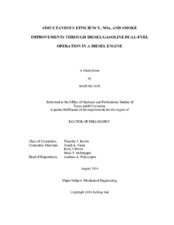| dc.description.abstract | Diesel/gasoline dual-fuel combustion uses both gasoline and diesel fuel in diesel engines to exploit their different reactivities. This operation combines the advantages of diesel fuel and gasoline while avoiding their disadvantages, attains spatially stratified low temperature combustion (LTC), and yields very low NOx and PM emissions while maintaining good efficiency. It is promising in solving the problems of conventional LTC through better control of ignition and combustion.
The benefits of dual-fuel operation and the potential of using gasoline fumigation to realize these benefits provide the major motivation to this research. This research is aimed at using gasoline fumigation in a medium-duty diesel engine to identify and quantify the influencing factors of diesel/gasoline dual-fuel LTC on engine efficiency and emissions. The factors include gasoline fraction, injection settings, rail pressure, intake pressure, and EGR level. This objective was realized through a series of experimental tests done at 1400 rpm and three loads, including both diesel baseline tests and dual-fuel tests.
First, design of experiments and relevant statistical techniques were applied to tests. Twenty-three best models between 6 factors (intake pressure, rail pressure, SOI for diesel baseline tests, SOI for dual-fuel tests, EGR level, and gasoline fraction) and 5 targets (efficiency, NOx, smoke number, HC, and CO) were obtained through regression of test data. Confirmation tests were done based on best models. Generally, the observations are improved NOx and smoke emissions, but unimproved or deteriorated efficiency, HC and CO emissions. The optimization effort makes some achievements, but needs further improvement. The influence of each factor is analyzed. The measures to get better models are explained.
Second, parametric studies of gasoline fraction and injection timing were done to find their influence on efficiency and emissions. Efficiency generally decreases slightly as gasoline fraction increases or injection timing is retarded. Generally, increasing gasoline fraction is beneficial for NOx and smoke emissions, but HC and CO emissions deteriorate. An advance in injection timing, however, has the opposite influence.
Finally, individual cycle data were analyzed to study cyclic variability (CV) and its influence on dual-fuel efficiency and emissions. Factors causing or influencing CV were identified. The CV in dual-fuel operation is more serious than that in diesel operation, in terms of magnitude. Most of the test data studied do not have strong determinism, and the influence of gasoline addition is small. | en |


